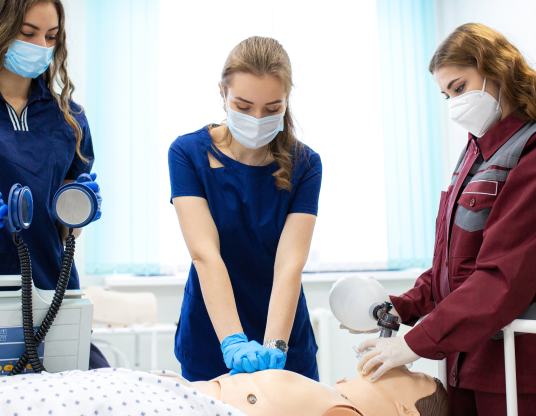Chapter 3: C-A-B
In 2010, the American Heart Association (AHA) and Emergency Cardiovascular Care (ECC) programs introduced a major change in the way CPR is performed. The long-standing A-B-C sequence—Airway, Breathing, Compressions—was flipped to C-A-B: Compressions, Airway, Breathing.
Why the change? Simple: chest compressions were being delayed, and that delay cost precious time when the heart and brain needed oxygen the most. Starting with compressions gets blood flowing faster, improving the chances of survival right from the start.
The steps of the C-A-B method are explained in detail in upcoming chapters, but here’s an overview:
- C – Compressions: Start with chest compressions at a rate of 100–120 per minute, using a cycle of 30 compressions followed by 2 breaths (30:2). Allow full chest recoil between compressions. Compression depth varies depending on whether the patient is an adult, child, or infant.
- A – Airway: Open the airway using the head-tilt, chin-lift technique.
- B – Breathing: Give 2 rescue breaths after each set of compressions.
CPR During COVID-19 (2021 Interim Guidance)
During the COVID-19 pandemic, PPE shortages and transmission risks made it necessary to adjust how CPR is performed—especially in healthcare settings. Key changes include:
- Always put on PPE before helping a patient in cardiac arrest
- Cover your mouth and nose (and the patient’s, if possible) with a face mask or cloth
For adults:
- Hands-only CPR is recommended if PPE is limited
- Skip rescue breaths, and focus on fast, strong chest compressions
For children:
- Start with chest compressions and rescue breaths
- If PPE is available, wear it. If not, a face covering may help reduce transmission risk
These guidelines aim to balance lifesaving care with protection for responders.
2025 Chest Compression Guidance
Updated CPR guidelines continue to recommend a compression rate of at least 100–120 per minute. Going too fast or compressing too deeply may reduce the heart’s ability to refill and negatively impact the outcome. Steady, controlled compressions are key to effective CPR.
Hands-Only CPR (2025 Update)
Sometimes, you may witness an adult or teen collapse unexpectedly—and you might not feel confident giving full CPR. That’s where hands-only CPR comes in. Here’s what to do:
- Call 9-1-1 and stay on the line with emergency responders
- Begin chest compressions immediately—push hard and fast in the center of the chest
This method skips the rescue breaths but is still proven to be effective—especially when done immediately. Thanks to Good Samaritan laws, you are legally protected when you step in to help.
This chapter is part of your Online Healthcare CPR/AED Course and gives you the foundation for safe, effective response using the modern C-A-B method.
